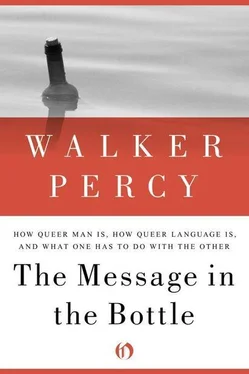A study of the aboriginal symbol relation will be seen to be highly relevant for the existentialia, in particular as it illuminates and rectifies existential theories about the nature of consciousness.
Sartre, for example, ontologizes the primary transphenomenal consciousness as the being-for-itself, and the transphenomenal object as being-in-itself. The prime reality of human consciousness is accordingly not the Cartesian cogito but a pure impersonal awareness, the “prereflective cognito.” Such an entity is probably fictitious, however, since consciousness is of its nature intersubjective. The originary act of consciousness is the joint affirmation that the object is there for you and me. The formula for the “prereflective cogito” is properly not the Cartesian
I am conscious of this chair
nor the Sartrean
There is consciousness of this chair
both of which presuppose consciousness but
This is a chair for you and me
which joint act of designation and affirmation by symbol is itself the constituent act of consciousness.
The symbolic corrective is that both the empiricists and the existentialists (excepting Marcel) are wrong in positing an autonomous consciousness, whether a series of conscious “states” or a solitary subjective existent. The decisive stroke against the myth of the autonomous Kantian subject is the intersubjective constitution of consciousness. There is a mutuality between the I and the Thou and the object which is in itself prime and irreducible. Once, in theorizing, this relation is ruptured, it cannot be recovered thereafter — witness the failure of both Sartre and the empiricists to give an account of intersubjectivity.
Thus the two term subject-object division of the world, as the situation in which one finds oneself, is not the original predicament of consciousness but rather a decadent “unauthentic” state, a falling away from an earlier communion.
(b) The self and the symbolized other. The world of the Nought and the world of the Other. Being-for-itself and Being-in-itself. Self as Nought.
It is of the nature of the symbol-mongering consciousness to delineate and transform all sensory data into intentional symbolic forms. The whole objectizing act of the mind is to render all things darstellbar, not “proper” but presentable, that is, formulable. The world before me is divided and configured into a great assembly of autonomous and resplendent forms. The naming judgment, This is a chair, That flower is a lupin — an identification which, as Marcel says, satisfies a peculiar need which has nothing to do with the definatory uses of the name — this naming act is both existential and figurative. It affirms that this is something, but in so rescuing the object from the flux of becoming, it pays the price of setting it forth as a static and isolated entity — a picture-book entity. But at any rate it is the requirement of consciousness that everything be something and willy-nilly everything is something— with one tremendous exception! The one thing in the world which by its very nature is not susceptible of a stable symbolic transformation is myself! I, who symbolize the world in order to know it, am destined to remain forever unknown to myself. The self, that which symbolizes, will, if it perverts its native project of being conscious of something else and tries to grasp itself as a something, either fail and remain as the unformulable, a nothingness (Sartre), the aching wound of self (Marcel) — or it will fall prey to miserable unauthentic transformations (the impersonations of Marcel and Sartre, and in primitive life, the totemic transformation: In the importunate need for construing all things, the self in its terrible inscrutability is as capable of being one thing as another; I can as well “be” a parakeet as an alligator — anything at all is more tolerable than the vacuum which I am). As Marcel puts it: It may be of my essence to be able to be not what I am.
The motto of the symbolic (and existential) predicament is: This is a chair for you and me, that is a tree, everything is something, you are what you are, but what am I?
In the situation-in-which-we-find-ourselves, two zones can be delineated, the zone of the nought and zone of the other. The nought of the self is not confined to the enclosure of the knower, but is expansile. The zone of the nought is coextensive with the domain of my property, in which there is a simultaneous exercise of my sovereignty of having and the exclusion of the other’s having. Yet what paradoxically characterizes the zone of having is the progressive annihilation of forms, an emptying out and a rendering nought by the very act of having. In the “passive unauthentic self which has fallen prey to things,” new things enter into the zone of the nought and are devoured. There is a real consumption of goods. A new product, an automobile, resplendent in its autonomous form (and endowed, we shall see later, with certain magic properties by virtue of the mystery and remotion of its manufacture) is loved for the sake of its form — what characterizes an idolatrous desire for a new car is not the need of a means of getting from one place to another but a prime desire to have the car itself. If I can have that car, my life will be different, for my nothingness will be informed by the having of it. But possession turns out to be a gradual neutralization. Once it enters the zone of my nought, the car is emptied out and, instead of informing me, only participates in my nothingness. There is a dynamic quest for resplendent forms — in two separate moments: the assumption of identities (impersonations), and the consumption of goods (in order to be informed by them).
(2) The ambiguity of the Thou. The Thou is at once the source of my consciousness, the companion and co-celebrant of my discovery of being — and the sole threat to my unauthentic constitution of myself.
The Thou is different from the other forms around me in that, while it can be objectized and relegated to the order of the stable configuration, it tends under certain conditions (the stare) to escape symbolization and to recover its unique and indispensable role in the sustaining and validating of my consciousness. When Sartre instances the stare of another as the supreme aggression, he is uncovering but one of two extreme alternatives. The look is of the order of pure intersubjectivity without the mediation of the symbol, and if it can be hatred in the exposure of my impersonation, it can also be love in the communion of selves. The unique importunacy of the look of another, the guardianship which one exercises over one’s own look, and the urgent need to deal with the look of another, derive from a tacit recognition of the absolute character of the alternatives — a look can only be an aggression or a communion, nothing else. It is not formulable. In the exchange of stares everything is at stake. L’enfer c’est autrui. But so is heaven. My vulnerability before the look derives from the aboriginal triadic communion of consciousness. The Thou is the knower, the namer, the co-inspector with me of the common thing and the authority for its name. Whatever devious constitution of self I have been able to arrive at, whatever my “self-system,” my impersonation, it melts away before the steady gaze of another.
Sartre is surely mistaken in analyzing the source of my shame at being caught out in an unworthy performance by the look of another. It is the other’s objectizing me, he says, that makes me ashamed. I had been aware of myself as not strictly coinciding with what I am. But when he looks at me, “I am sitting like that ink pot on the table…my original fall is the existence of the other, and shame is, in the same way as pride, the becoming aware of myself as a nature. ” But surely it is the other way around. What is revealed, as it seems to me, in the discovering look of another, is literally my unspeakableness (unformulability). To be taken for a nature, an ink pot, would be the purest happiness. No. I am exposed — as what? not as a something — as nothing, as that which unlike everything else in the world cannot be rendered darstellbar.
Читать дальше












